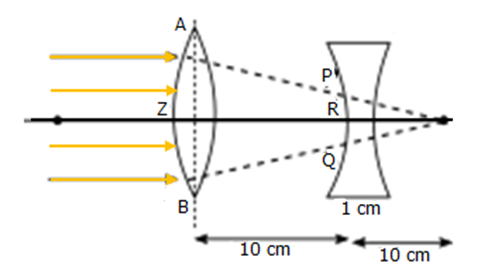A convex lens of focal length 20 cm and a concave lens of focal length 10 cm apart with their principal axes coinciding. A beam of light travelling parallel to the principal axis and having a beam diameter 5.0 mm, is incident on the combination. Show that the emergent beam is parallel to the incident one. Find the beam diameter of the emergent beam.
focal length of convex lens, ![]() = 20cm
= 20cm
focal length of Concave lens, ![]() = 10 cm
= 10 cm
diameter of the incident light, d= 5cm
distance between both the lens= 10cm
Let, the parallel beam is first incident on convex lens

Now, the image due to the convex lens will be formed on its focus (point B), So, for the concave lens,
The distance between object and lens, u= +10cm
Focal length of the lens= -10cm
By using lens formula,
![]()
![]()
![]()
So, the emergent beam becomes parallel after refraction in concave lens. As shown in figure, from the triangles XYB and PQB,
![]()
![]()
Thus, the beam diameter becomes 2.5 mm. Similarly, it can be proved that if the light is incident of the concave side, the beam diameter will be 1cm.